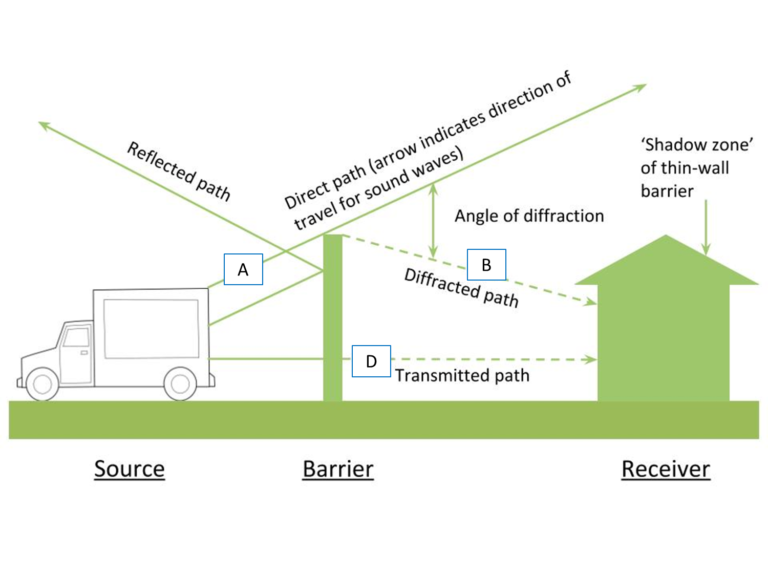While there is significant literature and testing available for interior wall partitions, many planning and architect professionals run into issues of exterior noise control.
In Europe, where often-times it is required to perform a Sound Study prior to new development, the US and many other countries are in a build and react mode. This sometimes leads to liability concerns, when there are few mitigation options available after construction.
The most Common Complaints are roadway noise (linear source) and outdoor construction or industrial activity (point source).
1. Exterior Noise Barriers
Outdoor barriers can be a very effective way to attenuate unwanted noise off of highways or from music venues. These are often seen as pre-cast concrete structures on the side of interstates, but may also include aluminum soundproofing panels near above-ground transit systems or flexible sound-blocking polymers near construction projects. The key to any effective barrier system is its height, proximity to the noise source, and barrier material. As a rule of thumb, the closer, taller, and thicker a barrier becomes, the more sound it will block. See the image below for an illustration.

Figure 1: Fresnel Calculation
The initial path of propagation was D, the distance from the source to the receiver. The sound must now travel up and over the barrier, a total distance of (A+B). The greater tha (A+B-D) becomes, the greater the difference in sound attenuation. This total value is higher (given a fixed barrier height) if the barrier is located closest to the source or receiver locations. Ultimately, the barrier should have a mass of at least 2 lbs/sq ft to ensure the diffraction up and over the wall is the primary constraint, rather than the transmission loss through the barrier.
2. Distance for Sound Power Loss
Another rule of thumb is that the Sound Power decreases by 6dB for every doubling of distance from the source. This begins at 25′, then again at 50′, 100′ and so on. So a concert at 100dB would be 76dB at 200′ away – a significant drop, but still well above most noise ordinances. It may be less if the sound is traveling over a lake or other water body. However, the amount of sound loss may be improved by up to 10dB every 100′ with “Heavy Vegetation” (these should be large-leaf plants that are thick all the way to the ground).
3. Noise Sources
Consider the noise source and how “annoying” it can be to the receiver. Steady drones from highways are less invasive than loud impulsive noises such as gunfire or hammering. As a rule of thumb, below is a table that illustrates noise coming off of a highway or primary road, and the suggested barrier height needed to achieve common background noise levels.

Figure 2: Roadway Noise by Distance
4. Composite STC – Sound Transmission Classification
Ultimately, the noise from the roadway or exterior source will be reduced by the facade of another building. However, when considering the level of attenuation a building provides, you must calculate the “Composite STC” – that is, a combination of the strong and weak facade elements that gives the total Sound Transmission Class of a building element. Unfortunately, a brick wall (STC ~55) with single-pane windows (STC ~25) will have a composite STC weighted heavily toward the windows, perhaps as low as 26-27 depending on the amount of window area. When this is the case, it is critical to treat the “low hanging fruit” (windows and other openings) to ensure that the overall sound-blocking most effective.
To learn more about soundproofing options, reach out to one of our acoustical consultants and schedule an initial meeting. We are headquartered in Tampa, FL, but provide soundproofing solutions across the Southeast and special projects across the US.



That’s a really good point — you have to consider what it is that is primarily making the noise in order to figure out what to do about it. Like you said, if the sound is a constant drone, that is usually much better than if the sound was loud and sudden. We are looking to move to a new house, but we’ve been told that there is a lot of noise in the neighborhood. Maybe we’ll look into hiring an acoustic measurements service so that we can test the noise and make sure it’s safe.
Hi Raisa, thank you for your comment. You can also check out the National Transportation Noise Map. It maps out noise levels in the United States and you can see if your neighborhood is particularly noisy before moving in. Feel free to reach out to us if you have any other questions!
Thanks for the information on how the height, proximity, and barrier material of the barrier system is important to make sure it’s effective. Talking to the right noise consultants, as well as other professions, would probably help you figure out which features will work best. You’d also want to work with a consultant so that they can test the noise levels to make sure that it’s where you want it.
Hi Tiffany,
I agree that talking to the right acoustical consultant will help you to determine what is best for your project. It’s helpful when the consultant has a background in all areas of soundproofing and acoustical treatment, such as sound blocking, sound masking, and sound absorption.
I agree that barriers are important when choosing noise control. It would seem that some key barriers would really help ensure that you find something that will reduce noise. My brother is looking for a noise control service, so he’ll have to find something that takes barriers into account.